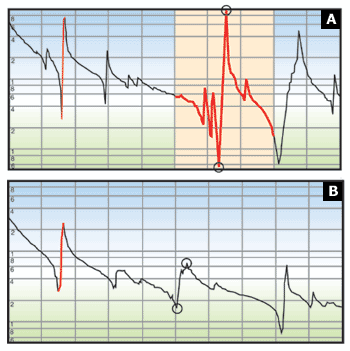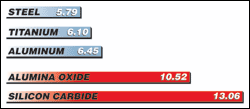Ceramically Enhanced Ultrasonics
An in-depth look at the advantages of ceramically enhanced transducer technology...
High-technology ceramics make possible the direct stacking of high frequencies that before were only available as subharmonics of metal stacked frequencies, which derive their primary power from the first harmonics (25 and 40 kHz). Stacking a ceramic transducer to the exact frequency results in a significantly higher level of activity and eliminates damage to sensitive parts associated with metal stacking.
Ceramics Transmit Sound Better
The acoustical speed at which sound travels through high-technology ceramics is 63%-125% greater than aluminum, stainless steel or titanium. The problem with traditional metal-stacked transducers is that solid metal is actually made up of strands and strands of metal, which under high magnification are actually quite porous. In the transmission of sound waves, the porosity becomes a significant limiting factor.
High-technology ceramics such as alumina oxide and silicon carbide, have a composition of molecules so minute, the porosity is near zero. Their surfaces are so flat they can be measured in 0.000001 inch. As a result, they offer superior acoustical speed and an improved surface interface. Thus, stacking an ultrasonic transducer with ceramics greatly enhances the transmission of ultrasonic energy. The near-perfect transmission of sound also reduces the amount of stress involved with transmitting ultrasonic energy, resulting in increased day-to-day reliability and a much longer trouble-free life for the system.
Featured Content
How Does It Work?
Taking into consideration the acoustic excellence, transmitting sound into the ceramic resonator directly before the aluminum head mass results in more sound waves transferred with greater intensity. The ceramic interface allows for the near perfect transmission of sound. Silicon carbide can further enhance the transmission of sound in some situations (see Fig. 3).
Third Harmonic Frequencies
Piezo ceramic crystals (PZTs) used for creating ultrasonic energy are known by their first frequencies, the traditional 40 kHz PZT (see Fig. 5). Expand the figure and you see an even stronger third harmonic frequency (Fig. 6). Looking at the figure's full spectrum, you will see a number of different harmonics (Fig. 7).
The harmonics are based on the number of signals that can be readily identified with some subjective expectations of strength that makes them useful. High-technology ceramics make possible the direct stacking of high frequencies that were previously only available as subharmonics of metal-stacked frequencies, which derive their primary power from first harmonics. Third harmonics are always stronger than first harmonics. Therefore, the direct stacking of third harmonics is highly desirable. Fifth and higher harmonics also offer good potential for future development.
Is it possible to create a third harmonic frequency at any point between 100 and 350 kHz? Yes, you can create third harmonics up to 500 kHz, but it would be cost prohibitive for the end user as you go above the 325-350 kHz range. The determining factors in creating third harmonics are the outer and inner dimensions of the PZT crystal.
The ceramic 132 kHz is not the universal transducer of the future. It is a great third harmonic frequency, but with ceramic stacking you have the luxury of having a family third and higher harmonics designed to meet specific needs. It allows one to avoid the metal-stacked frequencies (based on first harmonics) that can damage sensitive parts. Ceramic-stacked transducers enable users to avoid the damage of metal stacking.
The ceramic 200 kHz will challenge the megasonic frequencies and their modest intensity. Like other third harmonics, it is extremely intense for such a high frequency. With the ceramic intensity, it is likely to replace many megasonic units.
Transducers are expected to last several years compared to most megasonic transducers, which have a life expectancy of 6-12 months. Ceramic transducers have been in use for 3 years now worldwide without a transducer failure. These include applications such as disk cleaning, military applications, HSA/HGA yields in disk drive applications and PCB board cleaning.
To learn more visit Crest Ultrasonics Corp..





















